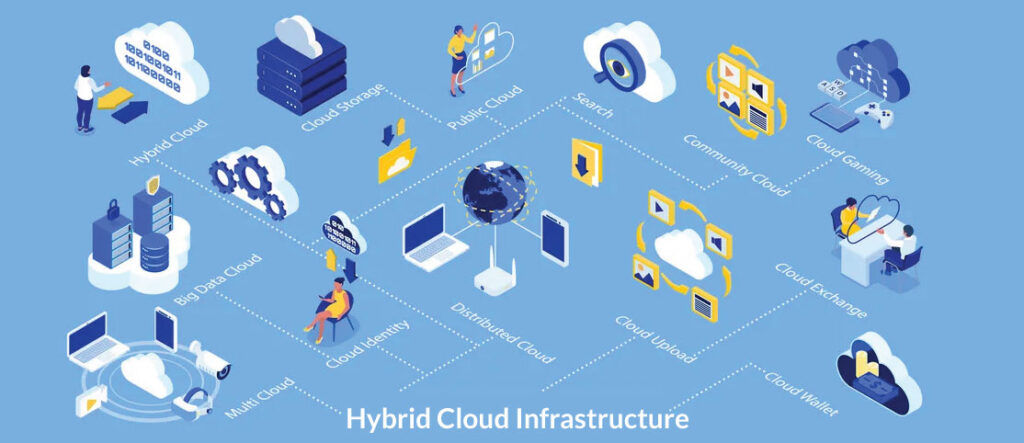A hybrid cloud infrastructure consists of both some on-premises cloud infrastructure that works in conjunction with one or more public clouds. It is one of the very popular models for infrastructure and application deployment among enterprises. There are several reasons why a hybrid cloud infrastructure might be a good option for your application deployment. Here are a few:
Flexibility:
A hybrid cloud allows you to use both public and private cloud resources, giving you the flexibility to choose the best option for each part of your application. This can help you optimize cost, performance, and security for your specific needs. In our experience when talking to our customers we have found that the following applications can benefit most from this flexibility
- AI/ML training and inference: Doing AI/ML training is a batch job which can be easily run on a group of on-premises servers. The demand is also quite predictable in this case. GPU based instances are very expensive and you don’t want to pay for every hour your team spends in trying out various parameters or weights. For inference, as the demand can fluctuate, you can use public cloud based containers in addition to on-premises cloud. This will make sure that the regular demand is handled using the high-performance and cost-optimized layer but the bursts can still be handled using a public cloud
- Big data analysis: Public clouds charge for storage, networking and compute separately. This gets very expensive for big data workloads where the data may sit there for a long time and the analysis may or may not yield a big insight. So you want a lower cost infrastructure to store the data as this is typically not OLTP data. Analysis can be done both on-premises or cloud by running the compute in those places.
- IoT data collection and analysis: IoT sensors are deployed in the field and can generate a lot of data everyday. It is better to store and do some analysis on the data closer to the sensors and then only store the results in the cloud
- Video Surveillance: Cameras produce a lot of data, which cannot be sent to cloud due to network limitations. Also storing the continuous video in cloud is too expensive just from storage point of view. Instead, one can store the data locally in a private cloud, run some local AI models and only send the interesting events to the cloud for longer term storage.
Scalability:
A hybrid cloud allows you to use both public and private cloud resources, giving you the flexibility to choose the best option for each part of your application. This can help you optimize cost, performance, and security for your specific needs. In our experience when talking to our customers we have found that the following applications can benefit most from this flexibility
- Test and Dev workloads: These workloads need to run all the time as part of a company’s CI infrastructure. Also it is not critical for this workload to run on highly reliable storage as most runs are repeated every few hours. It is cheapest to run this on on premise servers and use more expensive reliability features in the cloud for production workloads
- AI / ML Inference: Inference is used on customer data and the load can vary based on the seasonality or sudden demand due to marketing. One can plan to run the base inference on the on-premises cloud and use public clouds for scaling or bursting.
Disaster recovery:
Disaster recovery is one of the most critical and expensive component of any application deployment. By using both a public and private cloud, you can set up a disaster recovery plan that allows you to quickly failover to the other cloud in the event of an outage or other disaster. This can help ensure that your application remains available to your users, even in the face of unexpected issues. If you are running your production workload on-premises, then public cloud can be used a target for backup and also quick bring up of the application as most public clouds offer converting a snapshot to a storage backend using automated features.
Similarly if you are running your production application in a public cloud, the on-premises cloud can be a backup target and can be used to quickly bring up the application in case of a disaster. The on-premises cloud can be used for other workloads in the meantime as disaster is a rare event.
Also, one can use data sync tools to make sure that you have near sync replication across clouds without having to worry about expensive DR setup and replication.
Cost savings:
A hybrid cloud can help you save money by allowing you to take advantage of the cost benefits of the public cloud, while still maintaining control over sensitive or critical workloads in a private cloud. In a public cloud, you have to pay per use for all resources. This gets quite expensive for certain types for applications such as:
- AI/ML workloads
- Big data analysis
- Applications requiring large egress of data
- Any workload that runs 24/7
In such cases, one can set up an on-premises cloud to do optimal placement of the workload to lower cost significantly. We have done that for many of our customers and saved them significant cost, while providing control, flexibility and same ease of use as public clouds.
Overall, a hybrid cloud infrastructure can provide many benefits for application deployment, including flexibility, scalability, disaster recovery, and cost savings. It’s worth considering if you want to take advantage of the benefits of both public and private clouds for your specific needs.

